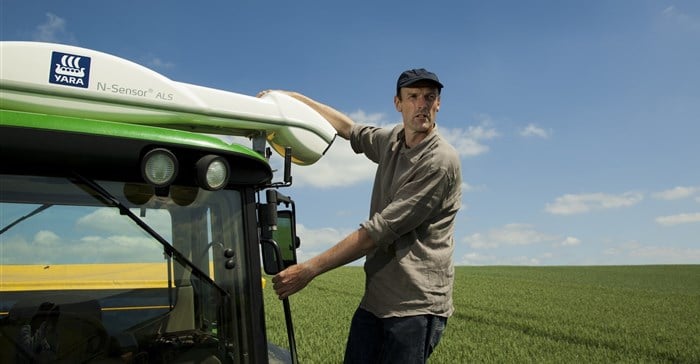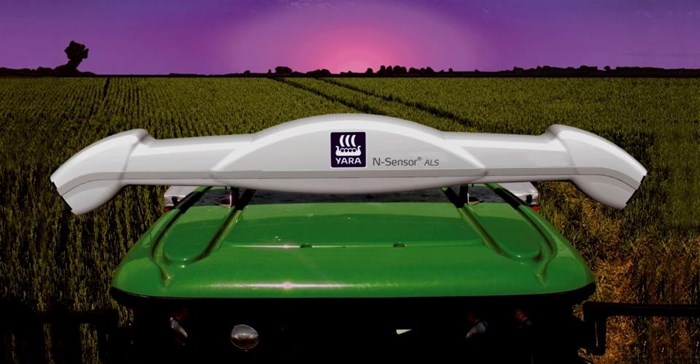Digitizing agriculture and growing knowledge

Yara International, provider of sustainable crop nutrition solutions, is digitizing agriculture by developing advanced tools and solutions for the farmer. We spoke to Magnus Rambraut, director Precision Farming at Yara to find out more about how digitizing the industry can alleviate pressure on farmers and ensure the future production of produce.
How is agriculture being digitized and to what extent have farms and farmers taken up these technologies?
The last few years have seen major changes in terms of digital agriculture, but it is actually not a new concept. Farmers have a history of being early technology adapters. In fact, farmers used the GPS long before private cars to steer the tractor along certain paths to avoid overlap in the spread of fertilizer. Recently, technologies such as remote sensing, digital soil maps, drones, smartphones, big data and cloud-based computing have all been introduced to the agricultural industry.
Digital crop sensors help determine the right use of precious resources like water, fertilizer, and arable land. This data can be stored and analyzed in the cloud alongside weather reports and soil maps, accessed by the farmers through their smartphones and sent back to sensors, which can then spread the right amount of resource. This is what we call smart agriculture or digital farming – and it is completely changing the way we think about farming.
Precision agriculture became a key strategic focus point for Yara in 2015, and we see that more people are getting involved in the movement. At Davos this year, for example, digital agriculture was a major theme, underlining the fact that the fourth industrial revolution has come to the farms as well. From Melbourne to Malawi, governments are increasingly encouraging the use of digital technologies in farming. This shows great prospects for the uptake of the technologies on a global scale, especially in terms of increased investments in farmer subsidies, research, and development.
We have already seen a gradual uptake of the technologies, but in developing countries farmers are still meeting some structural bottlenecks in terms of implementation. For smallholder farmers, especially in developing countries, digital financing has been the most important development so far. This helps promote financial inclusion and economic empowerment for smallholder farmers, which again gives them more financial stability to invest in digital agricultural products in the future.
How has digitization changed irrigation specifically, and why is it becoming increasingly important to embrace new irrigation technologies?
Water scarcity has become one of the biggest challenges we need to face. Droughts such as the one caused by the recent El Niño have caused major lack of water resources in Americas and Africa. In Asia climate change is threatening the water supply of one billion people. It is, therefore, important to embrace new irrigation technologies to reduce water waste.
Agriculture consumes about 70 percent of all freshwater withdrawals, and will have to do with less in the future. The Yara Water Technology is a great example of this. It contains a sensor with a magnet, which is placed on a leaf on the plant and measures the water pressures in the leaf between two magnets. Based on scientific research, we will be able to interpret the water pressure to indicate if the plant needs more or less water. The sensor is connected to a transmitter which transfers the data to our cloud-based solution (MyYara). It is also connected to the weather forecasts; so that the plants are not watered if it will rain in the near future. This ensures that water is only applied when needed, which may lead to major savings.

However, to further improve the nutrient use efficiency, Yara have developed a Fertigation solution (fertilizer applied through water) where we are able to provide both water and fertilizer recommendations for the farmer to ensure optimal production.
Tell us more about the Yara Sensors and the technology behind it.
In addition to the Yara Water Technology, we introduced the N-Sensor (Nitrogen sensor) to the market in the late 1990’s to help the farmer to apply the correct amount of fertilizer at the correct place on the field. The N-Sensor is a roof-mounted sensor for the tractor, which quickly determines the plants’ nitrogen requirement.
The N-Sensor measures each side of the tractor using wavelengths specifically designed to measure chlorophyll and biomass density. It collects data in real time and calculates how much fertilizer to spread. The information is sent to the tractor terminal, which is operating the fertilizer spreader and spreads accordingly. When completed, the details of the operation is sent to MyYara, where the farmer can access it to generate application heat maps and conduct analysis.

We also have complementary technologies, such as the handheld sensor N-Tester and the mobile app ImageIT. ImageIT lets the farmer take a picture of his or her crop with a smartphone, and will receive the nitrogen status of the crop and a recommendation on how much nitrogen to apply. As the GPS is today, we hope that the Yara sensors and precision farming will one day become the norm worldwide. All our tools are based on long-term scientific trials which we convert into rules/algorithms/calibrations, which are the basis for our recommendations.

How affordable is it for farmers who are already facing serious challenges in terms of drought, input costs, etc. to acquire this technology? What kind of benefits and ROI are farmers looking at?
Yara has a long history of doing business in Africa, dating back to the first consignment of fertilizers shipped to Egypt in 1929. We have recently opened a fertilizer terminal in Dar es Salaam to facilitate the growing agricultural sector, and we take part in multinational dialogues and public-private partnerships. These efforts include innovative projects and concepts such as the Agricultural Growth Corridors, the WEF framework New Vision for Agriculture, and the Grow Africa Partnership. Through these initiatives, we hope to make these technologies readily available for the African market. But acquiring new technologies always requires an initial investment.
In terms of return on investments, however, there is no doubt that it will help optimize the yield. Yara’s precision farming tools take into account the in-field variabilities of nitrogen needs and ultimately reduces fertilizer input, creates a more uniform crop stand and enhances overall yield and crop quality. In large-scale field trials in over five years, sensor-controlled fertilization increased yield by 6%, reduced nitrogen application by 12% and increased revenues by 57 euros per hectare on average. This holds huge potential, not only for the African industry but for farmers facing similar challenges worldwide.
Would you say smart agriculture and sustainable agriculture are two sides of the same coin? Why?
Absolutely. Climate smart agriculture underlines that smart, or digital, agriculture is the sustainable way to farm. The latest State of Food and Agriculture report from FAO shows that to feed future populations we must increase food production by 70% by 2050. The Global Opportunity Report proposes smart agriculture as a way for farmers to grow more with less. By doing so, farmers are reducing the use of precious resources like water, fertilizer, and arable land, and therefore contributing to a sustainable practice – hence producing more with less
In light of growing food insecurity, water scarcity, and climate change, to what extent can such technologies help farmers mitigate the risks of the day and contribute to a growing movement in sustainable agriculture. Can it really make a tangible difference?
Digital farming does not only help produce more food, it helps produce better quality food. A lot of the crops today are used as animal feed because it is not deemed good enough as food for humans. By gaining more and better output of our crops, we can help combat food insecurity.
Nitrogen fertilizers are a vital ingredient for modern agriculture and world food supply. But excess amounts of fertilizer have a negative impact on the environment. Optimizing input whilst maximizing output is a winning strategy from both an economic and ecological perspective. It proves that less really is more. Furthermore, in order to increase food production, we need to make better use of land that already exists, instead of increasing the amount of land we use for farming. This way we can help prevent further deforestation, which is vital to mitigate the effects of climate change.
For the farmers, gaining real-time access to information about weather, soil, nitrogen levels and water, they can avoid overusing valuable resources when it is not needed, and prepare for changes in farming practices when required. Look to Africa for example. Africa needs to import a lot of their food despite 65% of the population being farmers. The mobile phone has already been one of the most important changes to how they farm, and once other technologies are adapted they can become more food self-sufficient. I am certain that sustainable and digital agriculture not only can, but also will make a tangible difference.
Any other insights or tips on practicing smart and sustainable agriculture?
Although we aim to reach as far as possible, we cannot combat these challenges alone. On a global scale, we need to see increased government support and private-public partnerships to increase awareness and investments.
Innovations, as well as massive interventions on locally and regionally adapted levels, are all needed to gain the momentum needed. While a precision farming future is an ultimate goal, the here and now also calls for more educated methods, requiring widespread knowledge sharing, infrastructure development and inducement of enabling environments for functional value chains in the agricultural sector.
For the individual farmers, my tip would be to become more aware of your current farming practice and evaluate how to achieve optimal yields. At Yara, our slogan is “Knowledge Grows”, and this knowledge is available to everyone. In every major country, we have agronomists that help farmers analyze their needs, make decisions and get the best out of their investments.

























